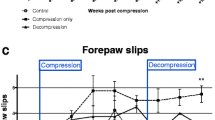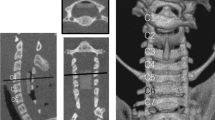Conclusions
In the spinal hyperostotic mouse model (twy/twy), at the C1-C2 level developing calcification and ossification, the area of neuronal soma and the length of the neurites significantly decreased with a decrement in the motoneuron population. The compression significantly decreased the expression levels of BDNF and NT-3, trkB, and trkC compared with the levels in adjacent, less-compressed segments. On the other hand, at other spinal cord segments sustaining less compressive stress, enlargement of the neuronal soma and elongation of neurites were observed in association with increased expression of BDNF, NT-3, and the receptor proteins trkB and trkC. In 20-week-old twy mice, separation of the myelin sheath from the axon and axonal swelling with deformation were signifi cant in association of increased mmunoreactivity to neurofi lament protein and growth-associated protein 43. Targeted retrograde adenovirus-BDNF-gene in vivo delivery via the sternomastoid muscle prevented loss of anterior horn neurons at the site of spinal cord compression, enhanced the expression of BDNF, and increased the activities of choline acetyltransferase and acetylcholine esterase in motoneurons of the twy mouse spinal cord.
Access this chapter
Tax calculation will be finalised at checkout
Purchases are for personal use only
Preview
Unable to display preview. Download preview PDF.
Similar content being viewed by others
References
Baba H, Furusawa N, Chen Q, Imura S, Tomita K (1995) Anterior decompressive surgery for cervical ossified posterior longitudinal ligament causing myeloradiculopathy. Paraplegia 33:18–24
Baba H, Uchida K, Maezawa Y, Furusawa N, Azuchi M, Imura S (1996) Lordotic alignment and posterior migration of the spinal cord following en bloc open-door laminoplasty for cervical myelopathy: a magnetic resonance imaging study. J Neurol 243:626–632
Baba H, Maezawa Y, Uchida K, Furusawa N, Wada M, Imura S (1997) Plasticity of the spinal cord contributes to neurological improvement in patients treated by cervical decompression: a magnetic resonance imaging study. J Neurol 244:455–460
Furusawa N, Baba H, Imura S, Fukuda M (1996) Characteristics and mechanism of ossification of the posterior longitudinal ligament in the tip-toe walking Yoshimura (twy) mouse. Eur J Histochem 40:199–210
Baba H, Furusawa N, Fukuda M, Maezawa Y, Imura S, Kawahara N, Nakahashi K, Tomita K (1997) Potential role of streptozotocin in enhancing ossification of the posterior longitudinal ligament of the cervical spine in the hereditary spinal hyperostotic mouse (twy/twy). Eur J Histochem 41:191–202
Uchida K, Baba H, Maezawa Y, Furukawa S, Furusawa N, Imura S (1998) Histological investigation of spinal cord lesions in the spinal hyperostotic mouse (twy/twy): morphological changes in anterior horn cells and immunoreactivity to neurotrophic factors. J Neurol 245:781–793
Frisén J, Verge VMK, Cullheim S, Persson H, Fried K, Middlemas DS, Hunter T, Hökfelt T, Risling M (1992) Increased levels of trkB mRNA and trkB protein-like immunoreactivity in the injured rat and cat spinal cord. Proc Natl Acad Sci USA 89:11282–11286
Baba H, Maezawa Y, Imura S, Kawahara N, Nakahashi K, Tomita K (1996) Quantitative analysis of the spinal cord motoneuron under chronic compression: an experimental observation in the mouse. J Neurol 243:109–116
Baba H, Maezawa Y, Uchida K, Imura S, Kawahara N, Tomita K, Kudo M (1997) Three-dimensional topographic analysis of spinal accessory motoneurons under chronic mechanical compression: an experimental study in the mouse. J Neurol 244:222–229
Baba H, Maezawa Y, Imura S, Kawahara N, Tomita K (1996) Spinal cord evoked potential for cervical and thoracic compressive myelopathy. Paraplegia 34:100–106
Baba H, Furusawa N, Imura S, Kawahara N, Tsuchiya H, Tomita K (1993) Late radiographic findings after anterior cervical fusion for spondylotic myeloradiculopathy. Spine 18:2167–2173
Yamaura I, Yone K, Nakahara S, Nagamine T, Baba, Uchida K, Komiya S (2002) Mechanism of destructive pathological changes in the spinal cord under chronic mechanical compression. Spine 27:21–26
Uchida K, Baba H, Furukawa S, Omiya M, Kokubo Y, Nakajima H (2003) Increased expression of neurotrophins and their receptors in the mechanically compressed spinal cord of the spinal hyperostotic mouse (twy/twy). Acta Neuropathol (Berl) 106:29–36
Uchida K, Baba H, Maezawa Y, Kubota C (2002) Progressive changes of neurofilament 68 and growth-associated protein-43 immunoreactivities at the site of cervical spinal cord compression in spinal hyperostotic mice. Spine 27:480–486
Baba H, Uchida K, Sadato N, Yonekura Y, Kamoto Y, Maezawa Y, Furusawa N, Abe S (1999) Potential usefulness of 18F-2-fluoro-deoxy-D-glucose-positron emission tomography in cervical compressive myelopathy. Spine 24:1449–1454
Uchida K, Kobayashi S, Yayama T, Kokubo Y, Nakajima H, Sadato N, Yonekura Y, Baba H (2004) Metabolic neuroimaging of the cervical spinal cord in patients with compressive myelopathy: a high-resolution emission tomography study. J Neurosurg Spine 1:72–79
Author information
Authors and Affiliations
Editor information
Editors and Affiliations
Rights and permissions
Copyright information
© 2006 Springer
About this chapter
Cite this chapter
Baba, H. et al. (2006). Spinal Cord Lesions in Spinal Hyperostotic Mouse (twy/twy) Simulating Ossification of the Posterior Longitudinal Ligament of the Cervical Spine. In: Yonenobu, K., Nakamura, K., Toyama, Y. (eds) OPLL. Springer, Tokyo. https://doi.org/10.1007/978-4-431-32563-5_15
Download citation
DOI: https://doi.org/10.1007/978-4-431-32563-5_15
Publisher Name: Springer, Tokyo
Print ISBN: 978-4-431-32561-1
Online ISBN: 978-4-431-32563-5
eBook Packages: MedicineMedicine (R0)




